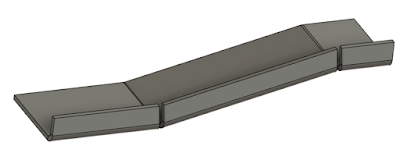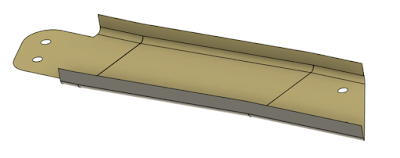 |
| The finished part. It looks simple, but it hides a suprise |
The part I chose looked to be a simple sheet metal part. It looked to be a simple enough part, but it did have a joggle in it that complicates things a bit.
 |
| The joggle that changed how this part was made |
 |
| The sheet metal version wasn't quite what I was after. |
I also decided I'd document how I did it here, for both posterity's sake, and in the hopes that it might give another struggling user an idea. I won't go through every single step, but I will give an overview that hopefully encompasses the high points.
The first thing I did was model the envelope. I nothing more than an extruded rectangle. A "brick".
 |
| The starting point. An extruded rectangle representing the parts outer dimensions. |
Next came the process of carving out the shape. I started with the joggle.
 |
| The joggles cut into the part. I've turned one of the sketches on to make it more visible. |
Once the joggle was in, it was a matter of adding the remaining features, including the outside fillets that represent the outer bend radius. Notice that the part is still a brick. It's just a brick with some nice looking features!
 |
| The brick has all the features of the sheet metal part now. |
But for some reason, I couldn't select the surfaces I wanted. I always ended up selecting a surface I didn't want.
So it was time for plan "B". I switched to the surfacing workbench and used delete face to remove all the faces except those that represented the outer profile of the part.
 |
| The part with all but the outer profile removed. |
In Conclusion
So is this the only way to do it? I doubt it. But it did get the result I was after in a way I was happy with. I'm sure someone out there has a different way of doing it, they may prefer it. And maybe someone out there has a way that's truly better. I would be thrilled if they do and I hope they share it!
How would this part be made in real life?
This is one place that I'm not an absolute expert, so I encourage others to chime in. But I do have some experience making sheet metal this way.
In production, a blank would be placed in a die, possibly using two of the holes to locate the part. Then a press would push the two die halves together, forming the part in one operation.
Here's a pretty good video on this process used for the ribs on an aircraft wing.
If the part is made in low production, A form block can be used, made out of wood or metal. The blank is then formed using a hammer.
He's a video on that process. While this video shows the process being done for steel, aluminum would be done in a similar manner.
The part I modeled in Fusion 360 calls for 24ST aluminum, which is the equivalent of 2024-T3. I know that 2024-T3 can crack when formed around tight bends, so it's possible they would have used 2024-0 (dead soft) and heat treated to the -T3 condition afterward. But that's one place I'd have to defer to the sheet metal experts, feel free to chime in!
And that's it, I hope this video was informative!
A Final Addendum, Murphy's Law Strikes!
As I finished up this post, I tried the shell one more time. Guess what! It worked! It seems I was just not quite getting the picks and clicks right when I tried it earlier. But I decided to go ahead and share the post anyway because I still feel it's a viable alternative.
 |
| It figures! The shell does work! |


No comments:
Post a Comment